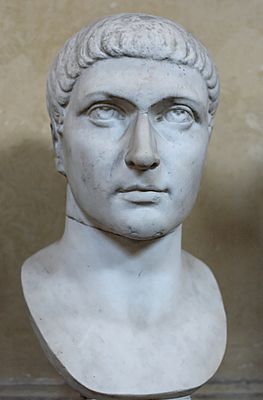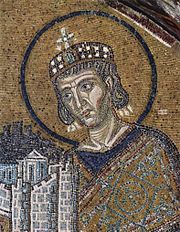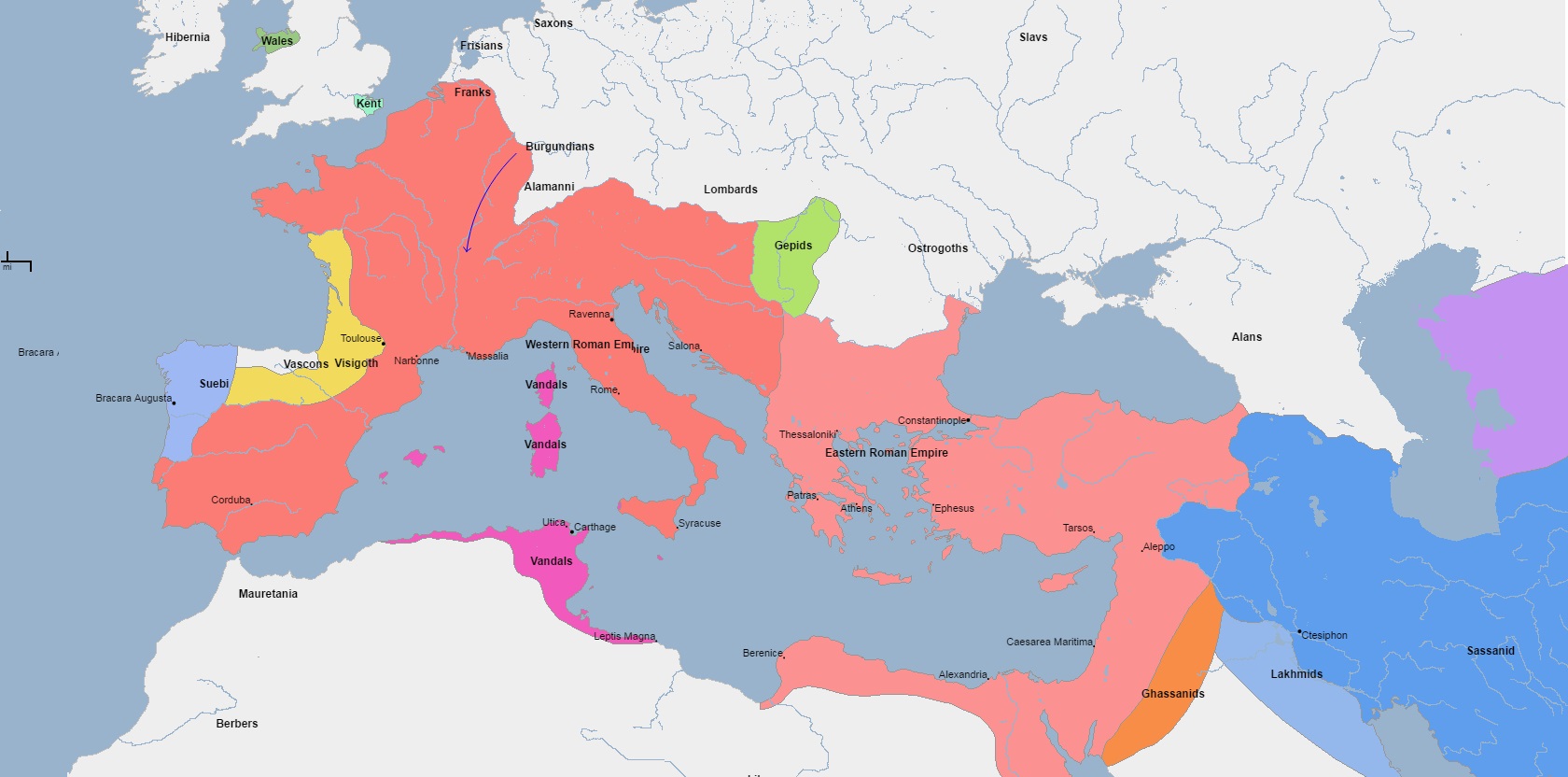Constantine I the Great
Flavius Valerius Aurelius Constantinus, also known as Constantine I or Constantine the Great (Latin: Flavius Valerius Aurelius Constantinus; February 27, 272 – May 22, 337), was a roman emperor. After the death of his father in 306, he was proclaimed Augustus by the army. Following his victory over Maxentius in the Battle of the Milvian Bridge in 312 and over Licinius in 324, he became the sole ruler of the Roman Empire. He made Christianity the dominant religion and in 330, he transferred the capital of the empire to a city he founded, initially called New Rome but later renamed Constantinople. He also reorganized the state structure.
The name of Constantine I is associated with the establishment of the dominat system in the Roman Empire, which granted the emperor unlimited power. The monarch enjoyed unprecedented honors and privileges. Constantine is venerated as a saint in some Christian churches, known as Saint Constantine the Great. However, the Roman Catholic Church did not include him in the list of its saints for a long time. After the Union of Brest, Constantine's name was added to the list of saints of the Catholic Church, and he is currently venerated as a saint in the Eastern rite on May 21 or June 3.
Constantine himself converted to Christianity only on his deathbed.
 Emperor Constantine I, 4th century AD
Emperor Constantine I, 4th century AD
Before Assuming the Title of Emperor
In 285, Emperor Diocletian established a new system of governing the empire, where power was shared among four rulers instead of one. Two of them were called Augusti (senior emperors) and the other two were Caesars (junior emperors). It was envisaged that after 20 years of rule, the Augusti would retire in favor of the Caesars, who would then appoint their own successors. In the same year, Diocletian chose Maximian as his co-ruler, assigning him control over the western part of the empire while keeping the eastern part for himself. In 293, the Augusti chose their successors. Constantine's father, Constantius, who was the prefect of Gaul at the time, became one of them, while Galerius, who later became one of the fiercest persecutors of Christians, took the other position. In 305, after 20 years since the establishment of the tetrarchy, both Augusti resigned, and Constantius Chlorus and Galerius became the full-fledged rulers of the empire, with Constantius ruling the West and Galerius the East. By this time, Constantius was already in poor health, and his co-ruler hoped for his swift death. Sensing his impending death, Constantius wished to see his son Constantine, who at that time was practically held hostage in the eastern capital of Nicomedia by the Augustus Galerius. Galerius did not want to let Constantine go to his father, fearing that the soldiers would declare him Augustus, which was not part of the emperor's plan. Initially, Galerius allowed Constantine to go, but quickly changed his mind and ordered him to be stopped. However, Constantine had already set off for Britain to join his father. The army proclaimed Constantine emperor after the death of his father Constantius I in 306 near Eboracum (modern-day York, United Kingdom).
Reluctantly, Galerius had to accept this, but under the pretext that Constantine was still too young, he only recognized him as Caesar. He appointed Severus as Augustus. Formally, Constantine held a subordinate position to Flavius Severus, but in reality, it was not the case. In Gaul, where Constantine resided, he had legions loyal to him personally, and thanks to his father's fair and just policies, the province's population trusted him. Flavius Severus did not have such a strong foundation.
Reign of Constantine
Upon becoming the sole ruler of the empire, Constantine continued the policies of Diocletian aimed at securing free peasants on their lands. However, taxes increased significantly as the empire needed resources for its restoration after 20 years of civil wars. Additionally, Constantine embarked on an ambitious building program, which also required additional expenses. Constantine divided the state into four prefectures: the East, Illyricum, Italy, and Gaul, which were further divided into smaller administrative units called dioceses. He also established a state council, the consistory, to advise the emperor. During Constantine's reign, the process of barbarization of the army continued.
In 314-324 AD, Constantine implemented a monetary reform, which was an improvement of the currency reform carried out by Emperor Diocletian in 296 AD.
At the beginning of his reign, Constantine, like all previous emperors, was a pagan. There are various versions regarding the reasons for his conversion to Christianity:
Miraculous visions: According to the account of Eusebius of Caesarea, during the war against Maxentius, Christ appeared to Constantine in a dream, commanding him to inscribe the Greek letters ΧΡ (Chi Rho) on the shields and banners of his soldiers. The following day, Constantine saw a vision of the cross in the sky and heard a voice saying, "By this sign, you shall conquer!" This sign led Constantine to victory in the Battle of the Milvian Bridge and turned him to the new faith.
The Murder of Crispus and Fausta.
According to the Byzantine historian Zosimus, who authored the "New History" in the 5th century with an anti-Christian bias, Constantine's conversion to the new religion was driven by his desire to avoid the wrath of the gods for the murder of his wife and son. Already an emperor at the time, Constantine killed his young wife Fausta and his son Crispus from a previous marriage, suspecting them of having an affair. Tormented by guilt, Constantine feared the vengeance of the Olympian gods, similar to the punishment that befell the mythical king Tantalus. The pagan priests, convened for counsel, unanimously concluded that such a crime could not be atoned for. The exception was a follower of Christianity, who assured the emperor that the Christian God forgives even the gravest sins. According to Zosimus, this circumstance was the reason for the abandonment of Diocletian's policies, which marked the end of persecutions against Christians and the acceptance of Christianity as the state religion of the Roman Empire.
 Constantine the Great brings the City as a gift to the Mother of God. Mosaic over the entrance to the Hagia Sophia
Constantine the Great brings the City as a gift to the Mother of God. Mosaic over the entrance to the Hagia Sophia
In any case, Constantine insisted on the adoption of freedom of religion (see the Edict of Milan). Christianity began to gain the status of a state religion: in the edict of 313, addressed to Anulinus, the proconsul of Africa, he exempted "the clergy of the Catholic Church, presided over by Cecilianus," from taxes and duties. In the same year of 313, he convened a council in Rome under the presidency of Pope Miltiades to settle the dispute between the Donatists and the Carthaginian bishop Cecilianus. The council decided against the Donatists, who appealed to Constantine; as a result, by his decree, the Donatist bishops were sentenced to exile, and their churches were confiscated.
The edict of 313 exempting the Church of Cecilianus from taxes was followed by a law in 319, in which he freed churches and the clergy from taxes and public duties. By the law of 321, he confirmed the churches' right to acquire and own real estate. Christian churches were built throughout the empire, sometimes by demolishing pagan temples, as ordered by Constantine.
By granting Christianity special status and supporting the Church, Constantine actively interfered in ecclesiastical affairs, seeking the unity of the Catholic (from the Greek καθολικὴ - universal) Church as a condition for the unity of the empire and acting as an arbiter in inter-church disputes. When a Trinitarian dispute arose between the Alexandrian priest Arius and Bishop Alexander, which threatened to cause a schism in the Church, Constantine convened the Council of Nicaea in 325, where he supported Alexander's supporters against the Arians. At this council, Constantine declared to the bishops, "You are bishops of the interior affairs of the Church, and I am the bishop appointed by God for the exterior affairs" (Greek: των εϊσω της εκκλησίας και των εκτός). At the council, Arianism was condemned, and by Constantine's decrees, Arius and several Arian bishops were exiled. Later, Constantine supported Arianism, and Athanasius the Great was condemned by the Council of Tyre.
Around 332, Constantine issued an edict for the destruction of pagan temples, which, apparently, was not fully implemented.
Constantine was baptized before his death by the Arian bishop Eusebius of Nicomedia, during which he himself leaned towards Arian teachings, after which church plundering and ecclesiastical discord ensued.
By the 4th century, the city of Rome ceased to be the residence of emperors. In the face of constant external threats, it was necessary for the ruler to be closer to the borders of the empire. From this perspective, the location of the capital was inconvenient. Therefore, starting with Diocletian, emperors established their residences in cities that better served the strategic defense goals of the state. These cities included Trier in Germany, Nicomedia in Asia Minor, Aquileia and Milan in northern Italy. Constantine was no exception to this rule. He visited Rome for the first time after his victory over Maxentius, and later he only visited it twice. Constantine was inspired by the dream of creating a new capital that would symbolize the beginning of a new era in the history of Rome. The foundation for the future city was the ancient Greek city of Byzantium, located on the European coast of the Bosporus. The old city was expanded and surrounded by impregnable fortress walls. The city was adorned with a hippodrome and numerous temples, both Christian and pagan. Artworks from all over the empire were brought to Byzantium: paintings, sculptures, and more. Construction began in the year 324, and after 6 years, on May 11, 330, Constantine officially moved the capital of the Roman Empire to Byzantium and renamed it Nova Roma (Greek: Νέα Ῥώμη, Latin: Nova Roma). However, this name was soon forgotten, and during the emperor's lifetime, the city came to be known as Constantinople.
In the early summer of the year 326, Constantine's son Crispus (Flavius Julius Crispus) was captured and executed by the order of his father, the emperor. Along with him, Constantine also executed his nephew, the young Licinius. The exact reasons for this are not known. It is likely that it happened due to the machinations of Crispus' stepmother Fausta, who sought to clear the way to the throne for her own sons. She accused Crispus of attempting to rape her and bribed several senators to confirm this. However, just a month after the execution of his son, Constantine apparently discovered the deception of his wife and ordered her to be locked in a bathhouse, where she died of heat suffocation. According to Eutropius, during this time, Constantine executed many of his friends.
 Roman Empire under Constantine I
Roman Empire under Constantine I
The last years of Constantine's reign
In the last years of Constantine's reign, on July 5, 328, the emperor personally inaugurated the "Bridge of Constantine" across the Danube in Sucidava, Dacia, which became the longest ancient river bridge. Its total length was 2,437 meters, with 1,137 meters crossing the Danube. The width of the bridge was 5.7 meters, and its height above the river level was 10 meters. Constantine planned to reclaim Dacia, which had been abandoned in 271 during the reign of Emperor Aurelian.
In 332, Constantine waged a joint war with the Sarmatians against the Goths. The Visigoths, led by Ariaric, emerged from Oium and advanced into Sarmatian territory in Dacia. The Sarmatians asked Constantine for help, and on April 20, 332, the Roman army, led by his son Constantine II, defeated the barbarians, reportedly starving and freezing to death about 100,000 of them. In 334, the Sarmatians staged a coup against their leaders, and then Constantine began a war against the Sarmatians. After defeating their forces, Constantine resettled.
After his successes in Dacia, Constantine plans to begin a war with the Sasanian Persia. In 338, the Treaty of Nisibis expired, and both countries were preparing for war. Constantine writes a letter to the Shahanshah Shapur II, in which he speaks of his patronage of Persian Christians and demands an end to the persecution that began after Rome adopted Christianity as the official religion. Constantine planned to be baptized in the Jordan River before entering Persian territory, but he fell ill in the spring of 337.
Realizing his imminent death, Constantine secretly prepared a burial place for himself in the Church of the Holy Apostles. But after Easter in 337, he felt worse and went to Helenopolis to use the baths. Initially, he sought treatment in the baths of Nicomedia, then resorted to the hot springs of Drepana, after which he settled in his capital villa at Ankyra. He summoned several Arian bishops, including Eusebius of Nicomedia, to be baptized. Gathering the bishops, he confessed that he had dreamed of being baptized in the waters of the Jordan but accepts it here according to the will of God. However, feeling worse, Constantine ordered himself to be transported to Nicomedia, where he was baptized by Eusebius of Nicomedia on May 22, 337. After Constantine's death, he was buried in the Church of the Holy Apostles.
Results
Constantine can be called the first Christian emperor, under whom a turning point occurred in the lives of Christians. Paganism took a back seat. Historians of Christianity, admiring his deeds, call him Constantine the Great, but no matter how powerful the emperor was, he could not halt the decline of the empire. The subsequent history of the Roman Empire is considered "Christian." Under him, the city of Byzantium became the capital, later renamed Constantinople.


